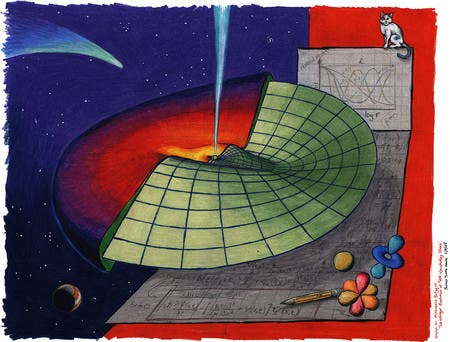Schrodinger’s equation is a fundamental equation of quantum mechanics that describes how particles behave at the subatomic level. Caltech researchers were astonished to learn, however, that the same equation popped up when they modeled the behavior of self-gravitating astrophysical disks. Examples of such disks include the rings of Saturn or the disks of gas and dust that surround young stars. However, there’s nothing ‘quantum’ about these objects — and yet there seems to be a connection.

Schrodinger’s equation is one of the cornerstones of quantum physics. It plays a similar role to Newton’s laws and conservation of energy in classical mechanics, describing how quantum objects (such as atoms and subatomic particles) tend to behave in the future based on their current state. When you get to that level, things start to get a bit bizarre.
One counter-intuitive behavior that Schrodinger’s equation describes is that subatomic particles behave more like a wave than like a particle, a phenomenon which physicists refer to as wave-particle duality.
Massive astronomical objects often have smaller objects gravitating around them, whether it’s stars going around a black hole or space debris around a star. This debris often arranges itself in a disk, like our solar system, for instance. The problem is that it’s always been challenging to study the behavior of self-gravitating disks because they exhibit distortions, bending and warping like ripples. Capturing the disks’ complexity can be challenging, which is what a team of researchers at Caltech is trying to address.
Konstantin Batygin, a Caltech assistant professor of planetary, and colleagues turned to perturbation theory in order to develop a mathematical representation of disk evolution. This simplified model, which is based on an equation developed by 18th-century mathematicians Joseph-Louis Lagrange and Pierre-Simon Laplace, assumes that the constituents of astronomical disks are mathematically smeared together into thin “wires”. These wires form concentric circles that loop around the disk and exchange orbital angular momentum.
Batygin looked at the extreme cases where the concentric circles get thinner and thinner until they merge into a continuous disk, and what this limit rendered proved quite surprising.
“When we do this with all the material in a disk, we can get more and more meticulous, representing the disk as an ever-larger number of ever-thinner wires,” Batygin said in a statement. “Eventually, you can approximate the number of wires in the disk to be infinite, which allows you to mathematically blur them together into a continuum. When I did this, astonishingly, the Schrodinger Equation emerged in my calculations.”
“This discovery is surprising because the Schrodinger Equation is an unlikely formula to arise when looking at distances on the order of light-years,” says Batygin. “The equations that are relevant to subatomic physics are generally not relevant to massive, astronomical phenomena. Thus, I was fascinated to find a situation in which an equation that is typically used only for very small systems also works in describing very large systems.”

The study published in the Monthly Notices of the Royal Astronomical Society suggests that the shape of the disk is well-represented by the wave function of a quantum particle that bounces around the inner and outer walls of a disk-like cavity. It’s unexpected to learn that such a fundamental equation to quantum mechanics, which scientists are used to dealing with almost exclusively in the domain of the “very small”, can also describe the long-term evolution of astrophysical disks. It’s an intriguing discovery that two seemingly unrelated branches of physics can be described so similarly, mathematically speaking — and such knowledge should prove useful for researchers who model astrophysical objects.
“Fundamentally, the Schrodinger Equation governs the evolution of wave-like disturbances.” says Batygin. “In a sense, the waves that represent the warps and lopsidedness of astrophysical disks are not too different from the waves on a vibrating string, which are themselves not too different from the motion of a quantum particle in a box. In retrospect, it seems like an obvious connection, but it’s exciting to begin to uncover the mathematical backbone behind this reciprocity.”


